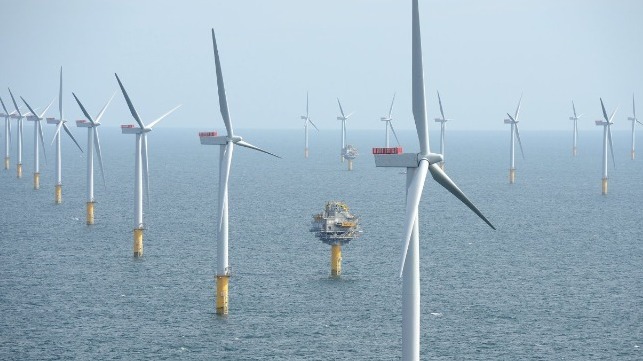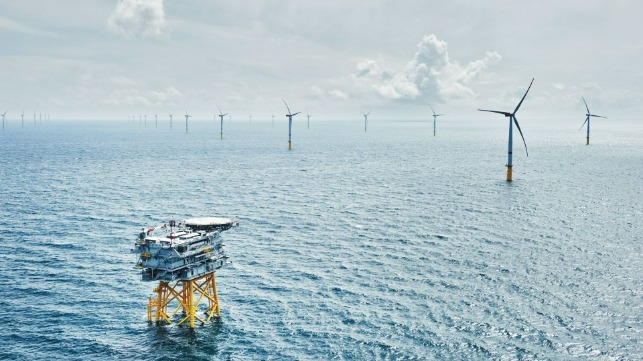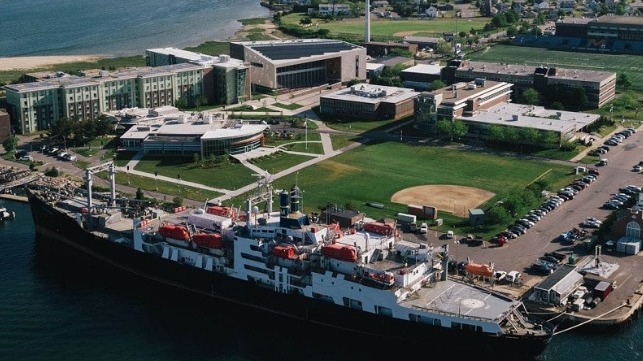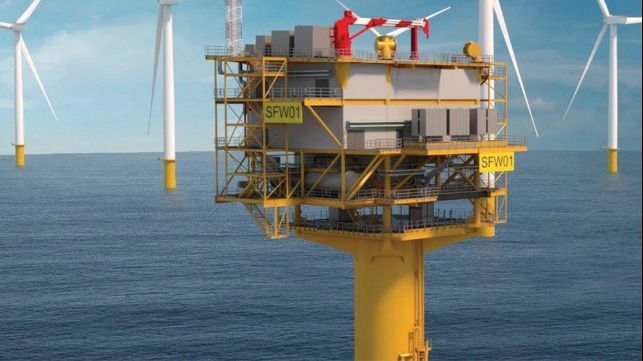Crown Estate Launches Study of Wind Farms' Impact on Marine Ecosystems

The UK royal family's property management firm, the Crown Estate, is set to carry out a research study on how massive offshore wind investments could impact marine ecosystems. The decision responds to concerns that wind farms could have adverse impacts on marine life.
The firm, which manages the U.K. sovereign’s public lands and the seabeds of England, Wales and Northern Ireland, has launched a program that is designed to address the critical gap in understanding how marine ecosystems will respond to the continued growth of offshore wind. The UK's thriving offshore wind sector is ramping up to deliver 40 GW of capacity by 2030.
The Crown Estate's new $9.5 million "ECOWind" program is a joint initiative led by the Natural Environment Research Council (NERC) and Defra.
“The U.K. has set a legal requirement to reach net zero greenhouse gas emissions by 2050, which will reduce our contribution to climate change. Expanding sustainable energy generation is at the heart of the government’s strategy but it’s important we understand the response from wildlife and marine ecosystems to help manage this sustainably,” said Susan Waldron, NERC’s Director of Research and Skills.
She added that the program will analyze the ecological consequence of large-scale expansion of offshore wind farms to inform future policy decisions throughout U.K. waters.
The four-year program will fund research into how offshore wind farms affect the marine environment alongside other growing pressures on U.K. ecosystems, including climate change and human activities like fishing. In particular, it will focus on how populations and inter-species interactions are responding to offshore wind deployment and how marine observations can be enhanced through innovative technologies.
The planned research comes as the U.K. is pumping massive investments in offshore wind projects, with a world-leading 11 GW of installed capacity and intentions to expand to 40 GW by 2030.
Globally, offshore wind installed capacity is projected to exceed 250 GW by 2030, up from 33 GW in 2002. The combined capital and operational expenditure for 2020-2030 stands at $810 billion, according to a Rystad Energy report.
Denmark to Commission Scandinavia's Largest Offshore Wind Farm

Next month, Danish households will start receiving electricity from Scandinavia's largest offshore wind farm, a development that marks another milestone in the country’s clean energy ambitions.
This follows the announcement by Swedish utility company Vattenfall AB that the inauguration of the 604 MW Kriegers Flak wind farm is set for September 6. The project, which is Scandinavia’s and Denmark’s largest offshore wind project so far, was constructed in the Baltic Sea at a cost of $1.4 billion.
It forms part of the country’s ambitious commitment to invest in clean energy: Denmark as a target of achieving a 70 percent reduction in greenhouse gas emissions by 2030, and aims to become a CO2-neutral nation by 2050.
The inauguration of the park follows the installation of the last turbine in June and finalization of testing and certification processes.
“We are very proud of the contribution that Kriegers Flak brings to the wind energy production in Denmark and to the green transition. After a successful construction process, Kriegers Flak is now ready to provide green power to Danish homes and industry,” said Anna Borg, Vattenfall CEO.
In June, Vattenfall completed the installation of the last of a total 72 offshore wind turbines in the wind farm located some 8-20 nautical miles off the east coast of Denmark. With an annual production capacity of 604 MW, the park will provide annual electricity consumption for approximately 600,000 Danish households, effectively increasing the Danish wind production by approximately 16 percent.
The offshore wind farm, which covers an area of 38 square nautical miles, features 72 Siemens Gamesa wind turbines, each with a capacity of 8.4MW. Each turbine has a total height of 615 feet and weighs up to 800 tons. About 90 nm of underwater cables have been laid to connect the project to the grid.
Denmark had 1.7 GW installed offshore wind capacity by the end of 2019. It has recently approved a plan to build an artificial island in the North Sea that will be a hub to hundreds of offshore turbines with a capacity to generate 10 GW, enough energy for 10 million households. The first stage will support up to 3 GW, and it is expected to cost $34 billion. Its operations should begin by 2033.
Crowley Launches Offshore Wind Training Program With Mass Maritime

Crowley Maritime and Massachusetts Maritime Academy have announced a training partnership to help create the offshore wind workforce that the U.S. will need for its growing renewable energy industry.
The first-of-its-kind training and workforce development program will be dedicated to the needs of the New England region's offshore wind energy industry. Though offshore wind is just getting started on the U.S. East Coast, it is expected to expand rapidly over the course of the next decade, boosted by support from federal policymakers, state governments, oil majors and investors.
The program will include sea safety and survival instruction and will be certified by the Global Wind Organisation (GWO), a non-profit that sets international standards for safety training. The academy will coordinate with Relyon Nutec, the world's largest provider of specialized instruction for energy and industrial sectors, to deliver the courses.
"Crowley and MMA are leaders in the maritime industry, and the joint program will help us build the next generation employee serving in the offshore wind industry," said Jeff Andreini, vice president, Crowley New Energy. "This partnership will provide workers the skills and knowledge they need, and together we help create cleaner energy sources in the U.S."
Crowley – a longtime supporter of the nation's maritime academies – will continue to provide scholarships, internships and hands-on learning for MMA cadets, including opportunities at sea and at the recently created Maritime Center for Responsible Energy (MCRE) on the MMA campus.
"Partnering with industry leaders is critical to our program at MMA. We're especially proud to team up with Crowley to help prepare the workforce for opportunities in the offshore wind industry," said Rear Admiral Francis X. McDonald, USMS, president of the Massachusetts Maritime Academy. "Training and internships will help our cadets gain expertise and experience, which will be critical as they pursue careers in this growing field."
Going beyond training, the Crowley/MMA offshore wind industry partnership will also create outreach programs and workforce development for underrepresented population groups, specifically in Massachusetts' Gateway Cities - the former manufacturing centers outside of Greater Boston that are in need of economic revival.
Milestone for Offshore Wind with Order for First US-Built Substation

In another milestone for the development of large-scale offshore wind farms in the United States, the first contract has been placed for an American-built offshore wind substation. The contract for the building of the critical component went to the largest offshore fabricator in the U.S. as part of an effort to leverage experience in the oil and gas sector to support the creation of the new offshore wind industry.
Orsted and Eversource, which are jointly developing the South Fork Wind project to be located off New York’s Long Island selected Kiewit Offshore Services to design and build the substation. The 1,500- ton, 60-foot-tall substation will be built at Kiewit’s facility in Ingleside, Texas, near Corpus Christi, creating more than 350 jobs.
“We’re helping to build a new U.S. manufacturing industry that will create thousands of good-paying jobs not just in the Northeast but in communities across the United States,” said David Hardy, Chief Executive Officer of Orsted Offshore North America. This initiative is part of our commitment to deliver for our long-term partners, combining international experience with local expertise in communities across the country.”
Offshore wind substations are critical components of utility-scale offshore wind farms. Substations collect the power produced by wind turbines and connect the energy to the grid. The offshore substation will consist of a topside resting on a monopile foundation.
Kiewit expects to begin construction on the substation in November and complete the work by spring 2023. The completed structure will transit the Gulf of Mexico and sail along the East Coast for installation at the South Fork Wind site in the summer of 2023.
"Achieving our nation's clean energy goals will be largely dependent on U.S.-based companies like Kiewit, and we are excited to partner with them to deliver the first U.S.-made offshore wind substation," Joe Nolan, Chief Executive Officer and President of Eversource Energy. "Our partnership with Kiewit marks another significant milestone for the U.S. offshore wind industry and signals the growth of the next great maritime industry throughout the country."
South Fork Wind continues to advance through the federal permitting process, with the Bureau of Ocean Energy Management issuing the project’s final Environmental Impact Statement on August 16. The partners expect South Fork Wind to be fully permitted in early 2022, with construction activities ramping up soon after the final permits are issued. They expect the project to begin producing energy by the end of 2023.
No comments:
Post a Comment